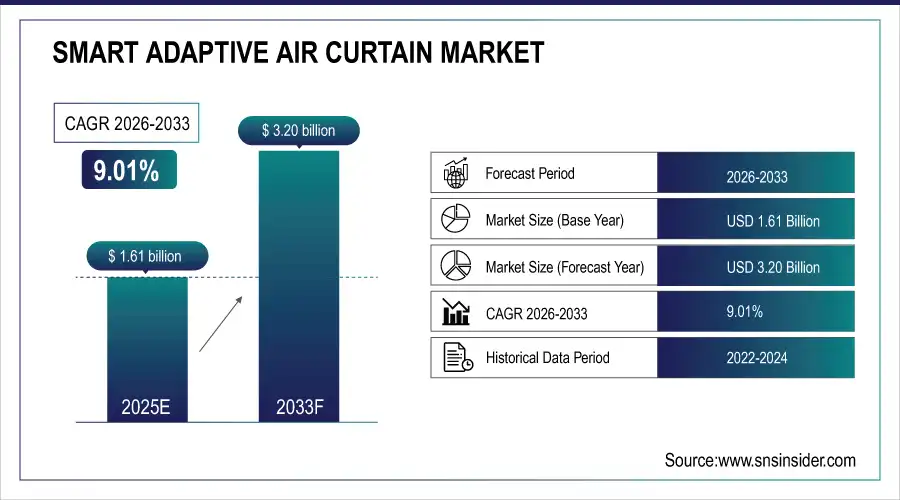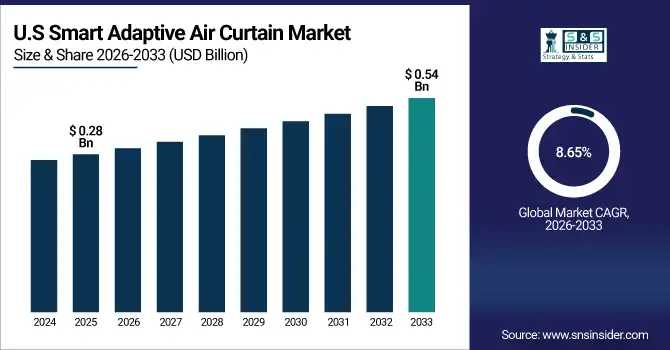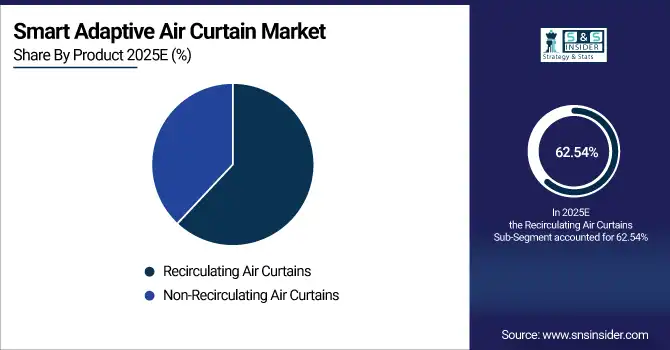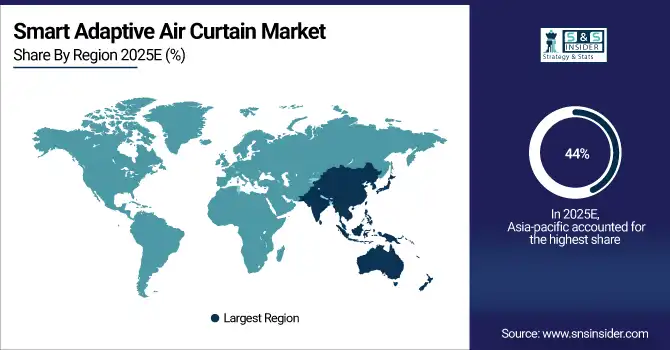Smart Adaptive Air Curtain Market Report Scope & Overview:
The Smart Adaptive Air Curtain Market size was valued at USD 1.61 Billion in 2025E and is projected to reach USD 3.20 Billion by 2033, growing at a CAGR of 9.01% during 2026-2033.
The Smart Adaptive Air Curtain Market analysis highlights the growing demand for energy-efficient and automatic HVAC solutions in commercial, industrial, and residential sectors is driving the growth of the smart adaptive air curtain. Sensors and IoT are very much in evidence giving accurate flow control and efficiency. Adoption is additionally accelerated by sustainability efforts and green building requirements. Deployment is fronted by big businesses, but SMEs are following suit very quickly. Growing demand for indoor air quality and cleanliness helps expand the market worldwide.
By 2025, over 70% of new commercial HVAC projects globally are projected to integrate IoT-enabled smart air curtains for enhanced energy efficiency and climate control.
Market Size and Forecast:
-
Market Size in 2025E: USD 1.61 Billion
-
Market Size by 2033: USD 3.20 Billion
-
CAGR: 9.01% from 2026 to 2033
-
Base Year: 2025
-
Forecast Period: 2026–2033
-
Historical Data: 2022–2024

To Get more information On Smart Adaptive Air Curtain Market- Request Free Sample Report
Smart Adaptive Air Curtain Market Trends
-
Increasing adoption of IoT-enabled and sensor-based air curtains enhances automation, real-time monitoring, and energy efficiency, driving demand across commercial buildings, industrial facilities, and healthcare environments globally.
-
Rising focus on sustainability and carbon neutrality pushes manufacturers to design eco-friendly air curtains with energy-efficient motors, reduced emissions, and compliance with global green building certification standards.
-
Growing integration of AI and machine learning algorithms enables predictive maintenance, airflow optimization, and adaptive control systems, improving performance while reducing operational costs and downtime for enterprises.
-
Expanding deployment in hospitality and healthcare sectors is driven by the need for hygienic environments, controlled airflow, and protection against contaminants, especially in urbanizing and developing regions.
-
Increasing investment in smart infrastructure projects and modernization of HVAC systems fuels demand for advanced air curtains, with large enterprises leading adoption and SMEs emerging as fastest-growing users.
The U.S. Smart Adaptive Air Curtain Market size was valued at USD 0.28 Billion in 2025E and is projected to reach USD 0.54 Billion by 2033, growing at a CAGR of 8.65% during 2026-2033. Smart Adaptive Air Curtain Market growth is driven by rising demand for energy-saving HVAC systems and development of stricter building energy codes are the factors boosting growth of U.S. smart adaptive air curtain market. Rise in use of IoT-based smart air curtains facilitates automation and real-time tracking. Installations are on the rise, with growth in commercial spaces like malls, offices and healthcare sites contributing to a big portion. With the environmentally friendly, low-emission systems supported by sustainability efforts.

Smart Adaptive Air Curtain Market Growth Drivers:
-
Rising Demand for Energy-Efficient HVAC Systems and Smart Building Automation Solutions
Smart Adaptive Air Curtain Market growth is driven by increasing focus on saving energy, operational cost and carbon footprint. Rising adoption of sensor-based and IoT-enabled solutions in commercial sector improves efficiency and automation. The growing need for integrated HVAC systems within contemporary smart structures will continue to drive market growth, with significant potential across key sectors including healthcare, hospitality, retail and enterprise.
In 2025, smart adaptive air curtains are expected to reduce operational HVAC costs by up to 25% in large retail chains through real-time occupancy and climate sensing. Nearly 70% of hospitality projects targeting green certifications in 2025 will integrate sensor-based air curtains to enhance guest comfort and meet sustainability benchmarks.
Smart Adaptive Air Curtain Market Restraints:
-
High Initial Installation Costs and Technical Complexity in Smart Adaptive Air Curtain Deployment
The Smart Adaptive Air Curtain Market faces several restraints that may hinder its growth potential. Even though the long-term energy savings justify the initial investment, upfront costs are a barrier to entry for small and medium sized businesses. Complexities in connecting up IoT-equipped systems with legacy HVAC contribute to cost. Lack of knowledge on long-term energy savings, and insufficient skilled personnel for the installation and maintenance also hinder market penetration, particularly in emerging countries with high cost sensitivity.
Smart Adaptive Air Curtain Market Opportunities:
-
Growing Sustainability Initiatives and Integration with Emerging Smart Infrastructure Development Projects
Global sustainability initiatives and tougher green building standards present a big opportunity for smart adaptive air curtains. Rising need for clean, cost-effective and low-emission solutions across commercial and industrial sectors is concurrently complementing the carbon neutrality targets. With smart city projects, and AI-driven automation – energy optimization also sometimes in as close to real-time as possible is the key for these solutions to be an integral part of sustainable modern building design, intelligent HVAC ecosystems around the world.
By 2025, over 60% of LEED-certified commercial buildings globally are expected to incorporate smart adaptive air curtains to meet stringent energy performance criteria. Smart adaptive air curtains are projected to reduce building envelope energy loss by up to 25% in 2025, supporting global carbon neutrality targets.
Smart Adaptive Air Curtain Market Segment Analysis
-
By Product, recirculating air curtains led the market with a 62.54% share in 2025, while non-recirculating air curtains are the fastest-growing segment with a CAGR of 11.20%.
-
By Application, commercial air curtains dominated 38.14% of the market in 2025, whereas healthcare applications are the fastest-growing segment, expanding at a CAGR of 10.14%.
-
By Technology, sensor-based air curtains led the market with a 42.62% share in 2025, while IoT-enabled solutions are growing fastest, registering a CAGR of 12.80%.
-
By Mounting Type, surface-mounted air curtains held 50.31% of the market in 2025, while suspended units are the fastest-growing segment with a CAGR of 9.70%.
-
By Distribution Channel, direct sales dominated with 55.27% in 2025, whereas online retail is the fastest-growing channel, registering a CAGR of 8.64%.
By Product, Recirculating Air Curtains Leads Market While Non-Recirculating Air Curtains Registers Fastest Growth
Recirculating air curtains held the dominant/largest Smart Adaptive Air Curtain market share, as they provide a good air distribution, energy saving and higher comfort levels in indoor climate - particularly in commercial and industrial premises. The fact that they aid in decreasing load in HVAC and are also environmentally friendly, makes them a favorite in green building designs. Non-recirculating air curtains are, experiencing the highest growth as these have reduced installation complexities and are cost-effective; and they are also being installed in small premises, retail stores and residential applications that require plain air separation rather than advanced circulation action.

By Application, Commercial Dominate While Healthcare Shows Rapid Growth
By applications, commercial segment leads the smart adaptive air curtains market as they are used widely in shopping malls, offices, airports, hospitality buildings etc., where energy efficiency and indoor comfort is of utmost importance. Increasing urban development and preference for sustainable business infrastructure are further propelling the segment. While Healthcare segment experiencing growth due to medical facilities are actually booming, they secure against infection and airborne contaminants.
By Technology, Sensor-Based Lead While IoT-Enabled Registers Fastest Growth
Sensor-Based air curtains are lead the market, due to air curtain that helps to promote automation by enabling it on demand and can relax at other times, thus increasing energy efficiency with minimal use. They’re still a common site in business/ industry where reliability is valued. IoT-based air curtains, meanwhile, are the fastest growing technology type due to their ability to enable remote monitoring and predictive maintenance in addition to integration with smart building systems. Their involvement in real-time energy monitoring and advanced connectivity is accelerating integration into smart infrastructure schemes everywhere.
By Mounting Type, Surface-Mounted Lead While Suspended Grow Fastest
Surface-mounted air curtains are leading the market, as they can be easily installed and serve for a wide range of commercial and industrial applications at low cost. They are commonly used in retrofitting and construction of standard structures. Suspended air curtains, are poised to register the fastest growth owing to their rapid penetration in vast commercial establishments including airports, malls and logistics centers. With better coverage and compatibility with modernized automation systems, this is best suited for the development of cutting-edge smart infrastructure.
By Distribution Channel, Direct Sales Lead While Online Retail Grow Fastest
Direct sales dominate the market due to strong business-to-business ties manufacturers and distributors have with commercial and industrial clients, providing tailor-made solutions, installation and after-sales services. That is the channel which controls procurement contracts at a large scale. While, the online retail is the fastest growing distribution channel as it allows greater access across geographies, competitive pricing and ease of access for SMEs and residential customers. It is also the online and digital shopping trends (stimulated by both, e-retailing and E-procurements) pushing for expansion in emerging market.
Smart Adaptive Air Curtain Market Regional Analysis:
Asia-pacific Smart Adaptive Air Curtain Market Insights
In 2025 Asia-Pacific dominated the Smart Adaptive Air Curtain Market and accounted for 44% of revenue share as well as witness the fastest growth with a projected CAGR of 10.38%, this leadership is due to the growing urbanization, commercial construction and industrial development. Increasing emphasis on energy efficient infrastructure widens applications in charters, malls and airports. Government measures of green buildings also promote adoptions. Strong growth potential comes from emerging markets like India and Southeast Asia.

Get Customized Report as per Your Business Requirement - Enquiry Now
China Smart Adaptive Air Curtain Market Insights
China leads APAC on the back of heavy commercial infrastructure and stringent energy savings policies. Strong adoption propelled by growth in retail, industrial and transportation sub-sectors. The fast pace of smart city projects drives up the need for IoT-based and sensor-centric solutions.
North America Smart Adaptive Air Curtain Market Insights
North America is witnessing a considerable adoption owing to accelerated building automation, the prevailing sustainability patterns and mandates for energy efficiency. Healthy market dynamics with big money driving innovation. Commercial buildings, hospitals and airports are early users. Rise in demand for IoT based devices also facilitate faster technological advances. Increasing focus on indoor air quality boosts regional growth prospects.
U.S. Smart Adaptive Air Curtain Market Insights
The U.S. account for a major share in the North American market owing to high acceptance in retail, hospitality and healthcare industries is a positive factor for expansion. Rising investments for smart building technologies to boost demand for IoT-Integrated Air Curtains.
Europe Smart Adaptive Air Curtain Market Insights
In 2025, Europe retains significant market share because of energy efficiency requirements and sustainability driven construction. Strong presence in commercial and industrial market supports lead. New opportunities are being driven by an increase in healthcare and hospitality investment. Certification for green building at EU level helps with implementation. The region is shining a spotlight on smart, automated and sensor-based systems that are in line with climate goals.
Germany Smart Adaptive Air Curtain Market Insights
Germany leads the pack and commercial/industrial sector adoption is significant there. Market growth is fueled by strict energy efficiency mandates and green building codes. Urbanization and development of modern retail infrastructure are driving demand.
Latin America (LATAM) and Middle East & Africa (MEA) Smart Adaptive Air Curtain Market Insights
The Smart Adaptive Air Curtain Market is experiencing moderate growth in the Latin America (LATAM) and Middle East & Africa (MEA) regions, due to the growing knowledge about energy-saving buildings. Demand is also driven by increased commercial building in Gulf nations and Brazil. Key growth drivers are the hospitality, healthcare and retail industry. Opportunities are increased by government-supported sustainability projects and foreign investment. Increasing saturation of digital consumer touchpoints drives access and diffusion.
Smart Adaptive Air Curtain Market Competitive Landscape:
Mitsubishi Electric With 40 years of experience in developing LoPro air curtain technology, Mitsubishi Electric specializes in providing advanced energy-efficient and intelligent solutions. The company is known for offering commercial and industrial HVAC solutions that are equipped with automation and sensor-based features. Its strong R&D, global reach, and a commitment to sustainability make Mitsubishi Electric one of the key players promoting innovation and adoption in the market.
-
In August, 2025, Mitsubishi Electric announced that its “SUSTIE” Net Zero Energy Building Test Facility received a regional ASHRAE award, recognizing innovation in energy-efficient building and sustainable HVAC technologies.
Panasonic Corporation is developing various kinds of eco-conscious flow systems to respond to the market demands such as air curtain, which creates an ideal environment with energy saving and a comfortable air-conditioning. Products and Services Its solutions focus on energy efficiency, indoor air quality and user comfort.
-
In March 2025, launched its 2025 line-up of smart air conditioners in India that include IoT-enabled controls via the Miraie app, extended to models with Matter compatibility, and built to endure ambient heat up to 55°C.
Systemair AB is a major European player in the field of ventilation and air movement products, such as customizable air curtains. The firm specializes in sustainable, smart technologies with sensor-based products for commercial, retail and industrial sectors. Europe’s powerful base and worldwide network of distribution channels, it guarantees easy compatibility to all competitive products wherever you are for economical, energy-efficient performance.
-
In July 2025, Acquired NADI Airtechnics Ltd in India, strengthening their industrial fans/environmental application portfolio including air-curtain-adjacent technologies.
Smart Adaptive Air Curtain Market Key Players:
Some of the Smart Adaptive Air Curtain Market Companies are:
-
Mitsubishi Electric Corporation
-
Panasonic Corporation
-
Systemair AB
-
Toshiba Corporation
-
Berner International GmbH
-
Mars Air Systems
-
Trotec GmbH
-
FläktGroup
-
Soler & Palau Group
-
Rosenberg Ventilatoren GmbH
-
Powered Aire Inc.
-
Biddle Air Systems
-
Envirotec Limited
-
Nedfon
-
Thermoscreens Ltd.
-
Airtecnics
-
Frico AB
-
VTS Group
-
Yanmar Holdings Co., Ltd.
-
Aleco (A Division of ES Robbins Corporation)
| Report Attributes | Details |
|---|---|
| Market Size in 2025E | USD 1.61 Billion |
| Market Size by 2033 | USD 3.20 Billion |
| CAGR | CAGR of 9.01% From 2026 to 2033 |
| Base Year | 2025E |
| Forecast Period | 2026-2033 |
| Historical Data | 2022-2024 |
| Report Scope & Coverage | Market Size, Segments Analysis, Competitive Landscape, Regional Analysis, DROC & SWOT Analysis, Forecast Outlook |
| Key Segments | • By Product (Recirculating Air Curtains, Non-Recirculating Air Curtains), • By Application (Commercial, Industrial, Residential, Healthcare, Hospitality, Retail, and Others) • By Technology (Sensor-Based, IoT-Enabled, Automated Control, Manual Control) • By Mounting Type (Recessed, Surface-Mounted, Suspended) • By Distribution Channel (Direct Sales, Online Retail, Distributors/Wholesalers, and Others) |
| Regional Analysis/Coverage | North America (US, Canada), Europe (Germany, UK, France, Italy, Spain, Russia, Poland, Rest of Europe), Asia Pacific (China, India, Japan, South Korea, Australia, ASEAN Countries, Rest of Asia Pacific), Middle East & Africa (UAE, Saudi Arabia, Qatar, South Africa, Rest of Middle East & Africa), Latin America (Brazil, Argentina, Mexico, Colombia, Rest of Latin America). |
| Company Profiles | Mitsubishi Electric Corporation, Panasonic Corporation, Systemair AB, Toshiba Corporation, Berner International GmbH, Mars Air Systems, Trotec GmbH, FläktGroup, Soler & Palau Group, Rosenberg Ventilatoren GmbH, Powered Aire Inc., Biddle Air Systems, Envirotec Limited, Nedfon, Thermoscreens Ltd., Airtecnics, Frico AB, VTS Group, Yanmar Holdings Co., Ltd., Aleco (A Division of ES Robbins Corporation) |

